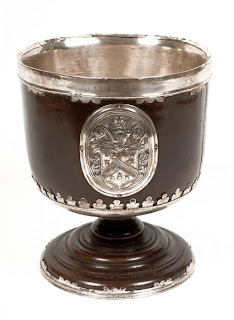
Although Wassailing today is synonymous with Christmas and 12th Night, its origin is in Anglo-Saxon pagan ritual that has seen many variations in its history. From the Middle Ages onward, peasants have solicited charitable spirit from their feudal lords with the Wassail. It was not begging. This distinction explains the lyric in the song "Here We Come A-Wassailing". The Wassailers inform the lord of the house that:
"We are not daily beggars that beg from door to door but we are friendly neighbors whom you have seen before."
Wassailing ceremonies took place at a number of different times throughout the year including Christmas, January 6th (Twelfth Night) and Shrove Tuesday.
In cider-producing areas of England (in another pagan-inspired tradition), wassailing refers to drinking (and singing) to the health of trees in the hopes that they might thrive in the coming year.
An old rhyme goes: “Wassaile the trees, that they may beare / You many a Plum and many a Peare: / For more or lesse fruits they will bring, / As you do give them Wassailing.”
The purpose of wassailing is to awake the cider apple trees and to scare away evil spirits to ensure a good harvest of fruit. The wassail was poured at the roots of a tree or soaked pieces of toast that were hung in the branches for the robins that represented good spirits. A gun was sometimes fired to scare away the bad spirits (after a few too many turns at the Wassail Bowl?).
Traditional Wassail bowls were made of lignum vitae in the 17th c, a wood that was virtually indestructible and extremely tolerant of alcohol. Fortunately, many beautiful examples remain.
There are surviving examples of "puzzle wassail bowls", with many spouts. As you attempt to drink from one of the spouts, you are drenched from another spout. The drink was either punch, mulled wine or spicy ale and the custom shows the playfulness of the celebration.
As for the drink itself, Robert Herrick, (1591-1674) said:
“Next crowne the bowle full
Adde sugar, nutmeg and ginger
With a store of ale too
And this ye must doe
To make a Wassaile a swinger.”

Wassail of the 17th-18th Century
1 lb of apples, cored and cooked at 375º for 1 hour in a foil covered baking dish. Remove peel when cool and mash... they should look fluffy like “lambs wool” when you are finished.
1-2 c light brown sugar (this should be to your taste and that of your ale)
6 bottles of ale (a double bock is a good choice)
1 c sherry
1nutmeg, grated
2 tsps ginger
1/8 t cloves
6 beaten eggs, optional
Toasted Bread slices, optional
Dissolve sugar in 1 bottle of the ale over low flame. Add spices and stir. Add rest of ale and sherry and remove from heat and let sit for several hours, covered. Warm and add the apple “wool”. You can add the eggs at this point if you would care to and beat it into a froth. Garnish with thin baked apple slices and the toasted bread if you wish.

Royal Lamb's Wool "Boil three pints of ale; - beat six eggs, the whites and yolks together; set both to the fire in a pewter pot;
add roasted apples, sugar, beaten nutmegs, cloves and ginger;
and, being well brewed,
drink it while hot."-Royal Household of 1633

Lamb's Wool
Place a pound of sugar in a large bowl and pour on a bottle of hot ale (A good hand crafted brown ale). Stir well. Grate about
1/2 of a nutmeg into this. Add 1 cup of sherry and five more bottles of ale. Let stand for several hours, then top off with several lemon slices
(roasted apple slices are perhaps more traditional) and two slices of toasted bread (the bread is traditionally white- better to absorb than the heavier breads?. -served by Sir Watkin Wynne to the faculty of Jesus College, Oxford University, in 1732:
If you want to change it over from an ale drink to a wine, there is also this alternative:
A recipe from The Book of Days, an 1863 history
Wassail
2,4,or 6 bottles of port, sherry or Madeira
12 egg yolks, 1 teacupful of water
6 egg whites 1/12 lbs sugar for 4 bottles of wine
12 roasted apples
For each bottle of wine used, take the following whole spices 10 grains mace (1), 46(3) grains cloves, 37(2.5) grains cardamon seeds 28(2) grains cinnamon 12(1) grains nutmeg 48(3) grains ginger 49(3) grains coriander. (I include the numbers in parenthesis to give a sense of proportion… figure a pinch is the closest to a grain… which is .00208 oz.)
Simmer the spices with the water and add to the wines with the sugar, warm and wish yolks and whites of eggs and pour some of the warm wine into the container… when you have a froth, add the roasted apples and serve it.
A very elaborate wassail set. This example includes not only the bowl and five of the six original cups, but a stand for them. The bowl has a cover with an integral container for spices on top in the form of a smaller bowl. Exhibition of Drinking Vessels Held at Vintner's Hall, London, 1933.
The Rare Wine Company has generously given me some spectacular Madeira to work with. During the next few weeks I'll be sharing some amazing Madeira-enhanced recipes... this is going to be fun! Stay tuned!







0 comments:
Post a Comment